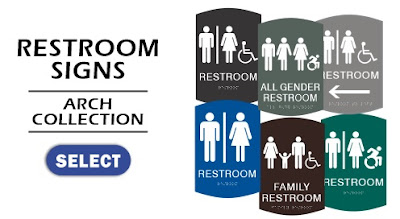How Braille Signs in Restrooms Are Helping the Visually Impaired
As human beings, we all want to be seen, recognized, and acknowledged, regardless of our abilities. For visually impaired individuals, this can be particularly challenging in public spaces, where inaccessible facilities can leave them feeling excluded and dependent on others for assistance.
This is where ADA compliant unisex restroom signs play a vital role in promoting inclusivity. Inclusivity, after all, is about recognizing and valuing the differences that make each person unique, including those with visual impairments.
In this article, we'll discuss how these signs are helping the visually impaired and why they are important.
The Importance of ADA Compliant Unisex Restroom Signs
Unisex restroom signs are an important aspect of creating an inclusive environment for all individuals, including those who are visually impaired. For visually impaired individuals, unisex restrooms can provide more convenience since they would not need to find a specifically-gendered restroom and can feel comfortable and safe using a unisex one.
Now, ADA compliant unisex restroom signs are not only a requirement by law, but are also an essential aspect of creating an inclusive environment. These signs make restrooms accessible to everyone, including those with visual impairments, impacting their way of life in more ways than one.
Emotionally, for example, these signs can provide a sense of security, as they know exactly where to go and which restroom is accessible to them. This can help them feel more independent because they can use the restroom on their own, without relying on others for assistance, thereby helping them gain higher level of confidence and self-esteem.
Physically, the simple act of adding these signs increases their sense of safety by clearly indicating the location of restrooms and providing information about accessible features, such as grab bars, raised toilet seats, and sinks with lever handles. This can help prevent accidents and injuries and make it easier for them to navigate public spaces and access essential facilities.
Mentally, ADA compliant unisex restroom signs can help reduce anxiety that some visually impaired individuals might experience with regards to finding the restroom. Providing clear and concise information about where the restrooms are, for example, can help alleviate the fear of getting lost or not being able to find the restroom. This helps improve their overall mental well-being, giving them less to stress about and more to be confident and proud in.
ADA compliant unisex restroom signs play a crucial role in creating an inclusive environment for the visually impaired individuals and eliminating the physical and emotional barriers that can prevent them from participating fully in social and public life.
Making Restrooms More Accessible
Before the introduction of ADA Compliant Unisex Restroom Signs, visually impaired individuals would often have to rely on the help of others or spend a lot of time searching for the restroom. With the introduction of Braille signs, restrooms have become more accessible to everyone, including the visually impaired.
When installing ADA compliant restroom signs, it is important to follow specific guidelines to ensure that they are accessible to visually impaired individuals. Here are some key considerations:
1. Placement
As you consider the placement of these ADA compliant signs, one thing you should definitely note is that these signs should be placed somewhere easy to see or is tactilely distinguishable from other surrounding surfaces. They should also be mounted at a height that is easily reachable for all users, including those in wheelchairs.
2. Contrast
When it comes to choosing the right kind of signage for visually impaired individuals, it's important to understand that there are actually varying levels of visual impairments. There are some individuals, for example, who are considered legally blind yet still have low vision. This small difference means that they're still able to perceive contrast.
For individuals with low vision, high contrast signage can be particularly helpful. Individuals with low vision may have difficulty seeing small print or low-contrast colors, making it challenging to read or recognize signage.
Choosing signs with high contrast, on the other hand, helps create a clear distinction between the text and background. For example, signs with black text on a white background or white text on a black background can provide a high level of contrast that makes the text more visible for individuals with low vision.
Of course, for individuals who are completely blind or have severe visual impairment, contrast doesn't really matter. In these cases, Braille and tactile signage is more helpful in being able to provide information about the location and function of the restroom.
3. Braille
Braille should be included on the sign to provide tactile information for visually impaired individuals. The Braille should be located directly below the printed text and should meet specific guidelines for size and spacing.
Make an Impact in Your Community with ADA Compliant Unisex Restroom Signs
The impact of braille signs on the visually impaired cannot be overstated. These signs provide a sense of independence and autonomy to those with visual impairments, allowing them to navigate public restrooms with confidence and ease.
So if you're looking for ADA compliant unisex restroom signs to mount inside your office building or space, check out our selection here at Braille Sign Pros. With over 20 years of experience in the ADA sign industry, you'll be able to find exactly what you need without having to worry about whether or not your signs are following regulations.







Comments
Post a Comment